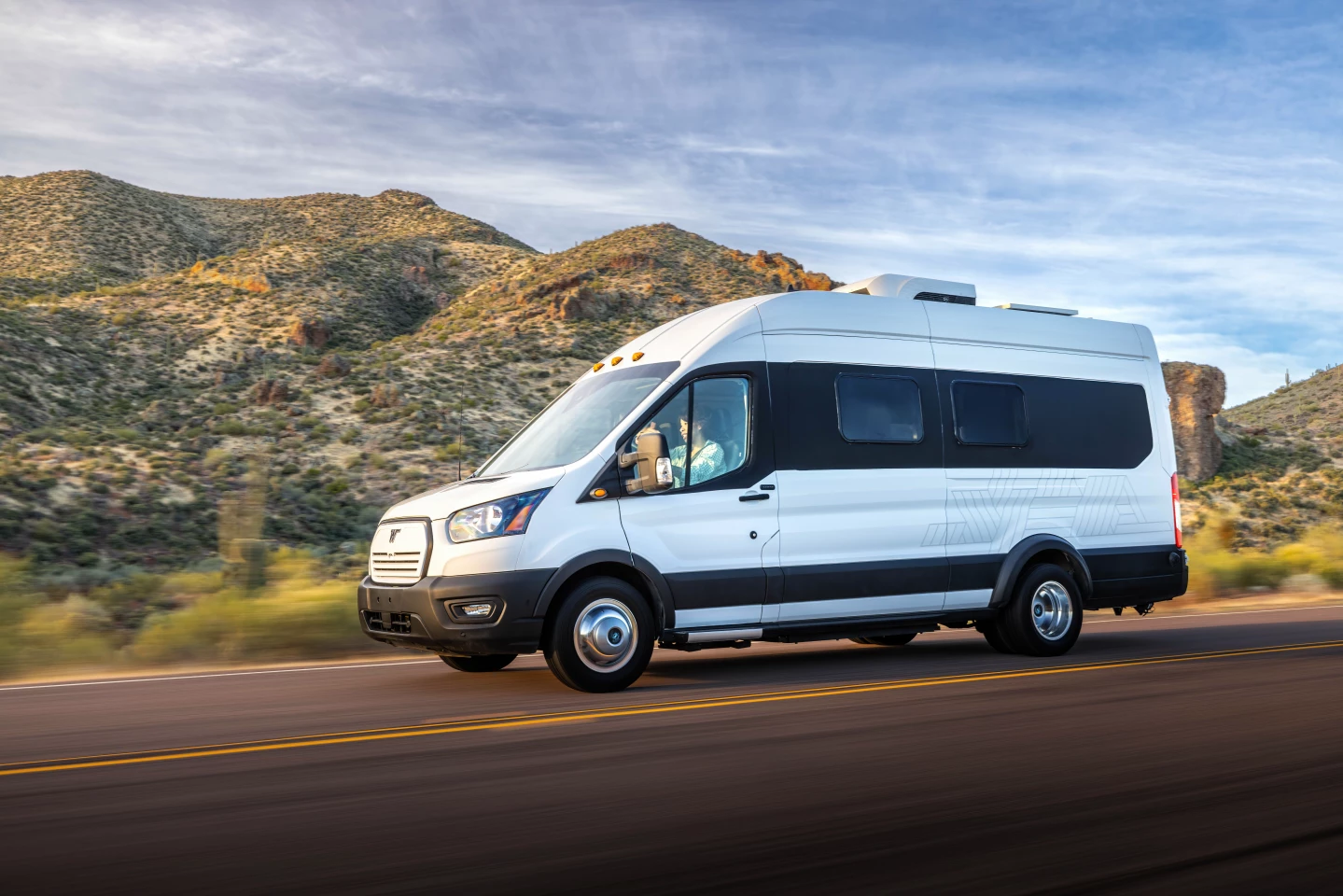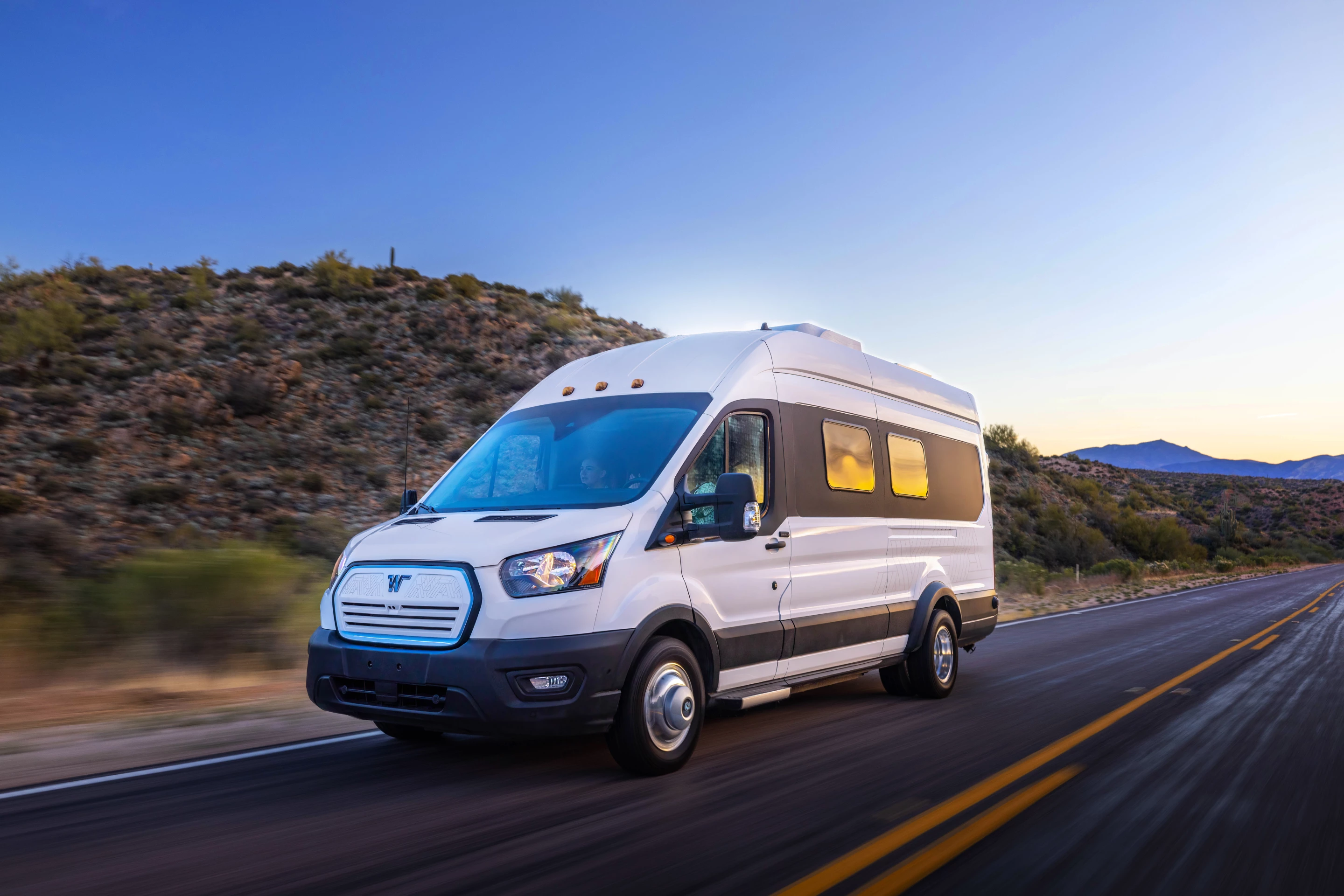As promised, Winnebago has kicked off the Florida RV SuperShow with a high-voltage bang, revealing the American market's first all-electric motorhome, a Ford Transit-based camper van with full floor plan. More than just a big battery and electric motor on a regular Winnebago camper, the e-RV concept is a completely reimagined all-electric camping experience that meets all driving and camping needs with its onboard 86-kWh battery pack. It won't be coming to your local RV dealership next quarter, but it's a critical first step in the motorhome industry's move into a zero-tailpipe-emissions electric future.
Electric RVs have made some tiny ripples in the European market, where for several years determined buyers have been able to find aftermarket conversions of small camper vans and even a larger Class C motorhome with up to 250 miles (400 km) of claimed range. They've even been able to roll a plug-and-play camper module inside a large electric cargo van and head for the farthest continental extremities.
The US market has been a very different story. A lack of all-electric van and truck chassis has led to an entirely predictable lack of all-electric motorhomes of any size or shape. The Rivian R1T camper truck with rooftop tent stands as the closest thing to an all-electric RV the US has seen.
Winnebago has taken the first steps toward changing all that with what it calls the e-RV concept. Given the aforementioned dearth of factory chassis with which to work, it ultimately collaborated with a third-party electrification shop. Colorado's eLightning Motors transformed the ICE-powered Ford Transit into the zero-emissions 86-kWh Transit that makes the e-RV concept possible.

That battery is larger than the 67-kWh unit Ford equips to the E-Transit, but it's smaller than the top 120-kWh 170-mile (274-km) option that eLightning offers for its Ford Transit cargo and passenger van conversions. We're surprised they didn't use the largest battery possible, since range is both highly important for a road-trip-ready camper van and under extra stress from the likes of added weight and more electrical draws.
Winnebago and eLightning do, in fact, power all onboard systems and equipment via the powertrain battery pack, eliminating reliance on LPG tanks or other fuels. A 350-volt DC architecture supports the water heater and air conditioner with heat pump, while 110-V AC power fires up the induction cooktop and keeps the fridge humming.

With all that in mind, Winnebago estimates e-RV range at 125 miles (201 km), competent enough for local sightseeing and camping, but certainly not ready for a (convenient) cross country road trip. According to Winnebago's research, though, that range will meet the needs of the 54 percent of new RV buyers who prefer to keep their trips under 200 miles (322 km), which further leads us to believe they should have added more battery and gotten closer to that 200. If that 200-mile trip is one-way, then drivers are looking at 400 total miles, with three charging stops along the way (maybe two if they hyper-mile their way to extra mileage).
But the e-RV is still an early concept and EV ranges in general are quickly rising, so we suspect a Winnebago e-camper van will boast 200+ miles by the time it gets close to market. And the 45-minute fast-charging time Winnebago estimates wouldn't be all that bad in a Tesla, let alone a full camper van in which occupants can prepare a complete meal or grab a nap on a proper bed. In addition to public fast charging, the e-RV can charge at home or properly equipped campgrounds.

To make the e-RV a technological showcase beyond electric drive power, Winnebago has added a comprehensive control system that looks similar to Mercedes' MBAC, combining onboard touchscreen operation and mobile control and monitoring. The system also optimizes electrical load efficiency. Winnebago says it aims for residential-grade Wi-Fi with a beefier, dual-modem router system.
As for living arrangements, the e-RV has a unique layout that differs from anything in Winnebago's current camper van lineup. The indoor/outdoor kitchen is at the passenger-side rear, across the aisle from the bathroom. A driver-side sofa converts over into a front bed, completing a configuration that's virtually the opposite of a typical camper van layout. When it comes to dining, an adjustable swivel table swings over the sofa, and two extra seats fold down across the way.

Winnebago completes its concept interior with the type of trendy sustainable materials that have become standard fare for concept cars. In this case, it's recycled-cork flooring and woolen wall trim.
Winnebago executives didn't surprise the Florida RV SuperShow today with availability or pricing estimates, emphasizing instead that the e-RV is a living concept that will continue its development. Over the next few months, Winnebago will solicit feedback from potential buyers and observers.
Source: Winnebago















